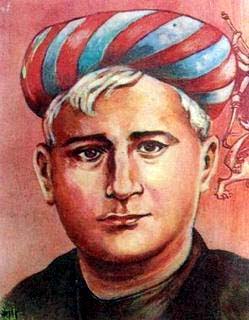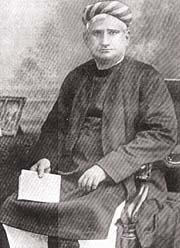<Back to Index>
- Mathematician Jørgen Pedersen Gram, 1850
- Author Bankim Chandra Chattopadhyay, 1838
- King of France Louis XII, 1462
PAGE SPONSOR


Bankim Chandra Chattopadhyay (27 June 1838 – 8 April 1894) ('Chattopadhyay' in the original Bengali; 'Chatterjee' as spelt by the British) was an Indian Bengali poet, novelist, essayist and journalist, most famous as the author of Vande Mataram or Bande Mataram, that inspired the freedom fighters of India, and was later declared the National Song of India.
Chatterjee
is widely regarded as a key figure in literary renaissance of Bengal as
well as India. Some of his writings, including novels, essays and
commentaries, were a breakaway from traditional verse oriented Indian
writings, and provided an inspiration for authors across India. Chattopadhyay was born in the village Kanthalpara in Naihati, in an orthodox bengali brahmin
family, the youngest of three brothers, to Yadav (or Jadab) Chandra
Chattopadhyaya and Durgadebi. His family was orthodox, and his father,
a government official who went on to become the Deputy Collector of Midnapur. One of his brothers, Sanjeeb Chandra Chatterjee , was also a novelist and he is known for his famous book "Palamau". He was educated at the Mohsin College in Hugli-Chinsura and later at the Presidency College, graduating with a degree in Arts in 1857. He was one of the first two graduates of the University of Calcutta. He later obtained a degree in Law as well, in 1869. He was appointed as Deputy Collector, just like his father, of Jessore,
Chatterjee went on to become a Deputy Magistrate, retiring from
government service in 1891. His years at work were peppered with
incidents that brought him into conflict with the ruling British.
However, he was made a Companion, Order of the Indian Empire in 1894. Chatterjee, following the model of Ishwarchandra Gupta,
began his literary career as a writer of verse. He soon realized,
however, that his talents lay in other directions, and turned to
fiction. His first attempt was a novel in Bengali submitted for a
declared prize. He did not win the prize, and the novelette was never published. His first fiction to appear in print was Rajmohan's Wife. It was written in English and was probably a translation of the novelette submitted for the prize. Durgeshnondini, his first Bengali romance and the first ever novel in Bengali, was published in 1865. Kapalkundala (1866) is Chatterjee's first major publication. The heroine of this novel, named after the mendicant woman in Bhavabhuti's Malatimadhava, is modelled partly after Kalidasa's Shakuntala and partly after Shakespeare's Miranda.
However, the partial similarities are only inferential analysis by
critics, and Chatterjee's heroine may be completely his original. He
had chosen Dariapur in Contai Subdivision as the background of this famous novel. His next romance, Mrinalini (1869),
marks his first attempt to set his story against a larger historical
context. This book marks the shift from Chatterjee's early career, in
which he was strictly a writer of romances, to a later period in which
he aimed to stimulate the intellect of the Bengali speaking people and
bring about a cultural renaissance of Bengali literature. He started
publishing a monthly literary magazine Bangodarshan in
April 1872, the first edition of which was filled almost entirely with
his own work. The magazine carried serialized novels, stories, humorous
sketches, historical and miscellaneous essays, informative articles, religious discourses, literary criticisms and reviews. Vishabriksha (The Poison Tree, 1873) is the first novel of Chatterjee that appeared serially in Bangodarshan. Bangodarshan went out of circulation after 4 years. It was later revived by his brother, Sanjeeb Chandra Chatterjee. Chatterjee's next major novel was Chandrasekhar (1877),
which contains two largely unrelated parallel plots. Although the scene
is once shifted back to eighteenth century, the novel is not
historical. His next novel was Rajani (1877), an autobiographical plot, with a blind girl in the title role. Autobiographical plots existed in the techniques of Wilkie Collins' "A Woman in White", and a blind girl in a central role existed in Edward Bulwer-Lytton's Nydia in "The Last Days of Pompeii", though the similarities of Rajani with these publications end there. In Krishnakanter Will (Krishnakanta's
Will, 1878) Chatterjee produced a complex plot. In that complexity,
critics saw resemblance of Western novels. The plot is somewhat akin to
that of Poison Tree. The only novel of Chatterjee that can truly be considered historical fiction is Rajsimha (1881, rewritten and enlarged 1893). Anandamath (The
Abbey of Bliss, 1882) is a political novel which depicts a Sannyasi
(Hindu ascetic) army fighting the soldiers of the Muslim Nawab of Murshidabad.
The book calls for the rise of Hindu nationalism to uproot the foreign
Turko-Afghan Muslim rule of Bengal and put forth as a temporary
alternative the East India Company till Hindus were fit for Self Rule. The novel was also the source of the song Vande Mataram (I worship the Motherland as Mother) which, set to music by Rabindranath Tagore, was taken up by many Indian nationalists, and is now the National Song of India. The novel is loosely based on the time of the Sannyasi Rebellion, however in the actual rebellion, Hindus sannyasis and Muslim fakirs both rebelled against the British East India Company. The novel first appeared in serial form in Bangadarshan. Chatterjee's next novel, Devi Chaudhurani, was published in 1884. His final novel, Sitaram (1886),
tells the story of a local Hindu lord, torn between his wife and the
woman he desires but unable to attain, makes a series of blunders and
takes arrogant, self-destructive decisions. Finally, he must confront
his self and motivate the few loyal soldiers that stand between his
estate and the Muslim Nabab's army about to take over. Chatterjee's humorous sketches are his best known works other than his novels. Kamalakanter Daptar (From the Desk of Kamalakanta, 1875; enlarged as Kamalakanta, 1885) contains half humorous and half serious sketches. Kamalakanta is an opium addict, similar to De Quincey's Confessions of an English Opium Eater, but Chatterjee goes much beyond with his deft handling of sarcastic, political messages that Kamalakanta delivers. Some
critics, like Pramathnath Bishi, consider Chatterjee as the best
novelist in Bangla literature. They believe that few writers in world
literature have excelled in both philosophy and art as Bankim has done.
They argue that in a colonised nation Bankim could not overlook
politics. He was one of the first intellectuals who wrote in a British
colony, accepting and rejecting the status at the same time. Bishi also
rejects the division of Bankim in `Bankim the artist' and `Bankim the
moralist' - for Bankim must be read as a whole. The artist in Bankim
cannot be understood unless you understand him as a moralist and vice
versa. He
was married at a very young of age of eleven, his first wife died in
1859. He later married Rajalakshmi Devi. They had three daughters.